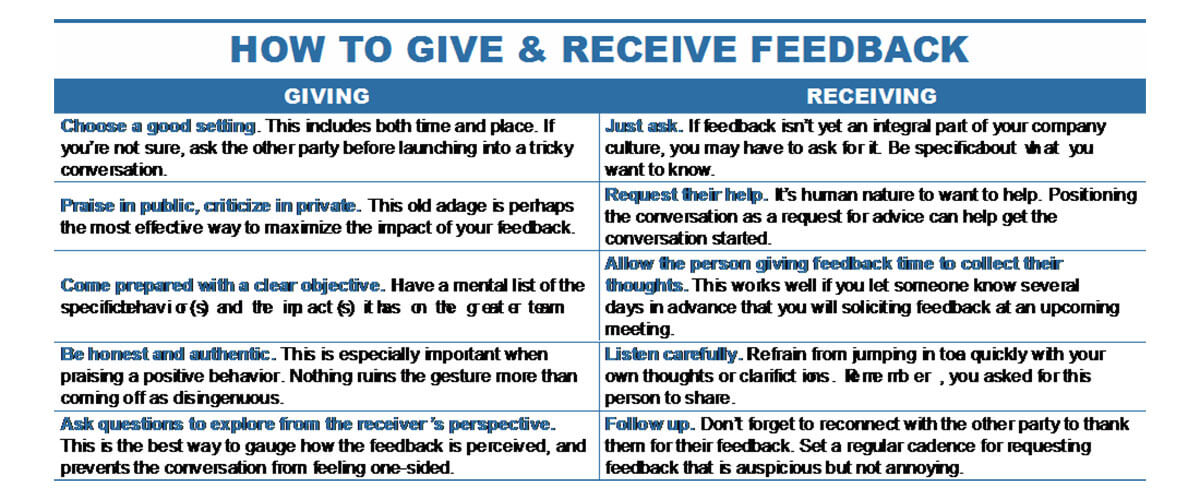
A Skill Worth Developing
Giving and receiving feedback is a skill that pays big dividends for personal development. And like any skill it can be developed. At DISHER, when I am working on complex project teams with multiple parties, being able to communicate feedback often and effectively helps build trust among the team and enables the team to work at a higher level of performance.
Everyone can benefit from further nurturing their feedback skills. It’s not enough to give or receive feedback during an annual review or at quarterly all-hands meetings. People need feedback on a regular, consistent basis. While it can take years of practice to fully develop, the specific act of giving feedback doesn’t take much time at all. The most effective leaders find daily opportunities to recognize a positive behavior or share an encouraging word. As Mark Twain famously said, “I can live for two months on a good compliment.” Great leaders are also intentional about providing constructive feedback to help others reach their full potential.
Data Up, Decisions Down
During the summer months in my spare time, you can find me working on or around sailboats here in Holland. While I do enjoy kicking back on a casual sunset sail, my real passion is racing. I have had the opportunity to crew on sailboats of all sizes, all over the country, in a variety of positions. I’ve had roles from Captain down to the guy who sits quietly on the wet rail, using their body weight to keep the boat from heeling over excessively. All positions are important, but some are more critical.

One of my favorite boats to race on is Marauder. It’s a J/29 owned and captained by Dick Parker and crewed by a rotating team of exceptional sailors, each with countless years of experience. A boat like Marauder sails best when pushed to the limit, in a state of delicate balance between the many forces acting on the boat. The only way to keep the boat in this state of balance is through constant feedback from everyone on board. Trimmers are negotiating course with the skipper to keep the sails full while the foredeck crew discusses the next sail change. Meanwhile, the tactician is studying the ever-changing conditions and watching competitor positions to find strategic opportunities on the course.
An interesting thing happens when you fill a boat (or any team) with a crew of A+ players; the intricacies of giving and receiving feedback changes. Nobody likes to be told how to do their job. This counts double when the guy barking orders is sitting on the rail. What I have learned in these situations is that it is best to send information up the chain of command rather than trying to communicate a decision yourself from your limited perspective. This change in mindset sets apart a value-add teammate from an irritating backseat driver. When the skipper has a steady stream of quality information as their disposal, they can focus on timing the critical actions that make up the seconds between first and second place.
To put it simply, data goes up and decisions come down. Don’t tell a person how to do their job, no matter what your role is in the organization. Instead, give your teammates the information and tools they need to be successful.
Ways to Give and Receive Feedback
When considering the best methods for delivering feedback, whether positive or constructive, it is best to remember the Golden Rule: “Give feedback as you wish to receive it.” If you’re not quite sure how that translates into actionable steps, here are a few tips.

Lead with Grace, Follow with Truth
If you’ve had the opportunity to hear Jeff Disher speak recently, you may have heard him discuss the need to balance grace with truth. “Truth without grace is harsh,” Jeff explains, “and grace without truth is tolerance.” But when both are present while giving feedback, the moment that follows is a learning opportunity that builds trust between both parties.
When looking to create an environment that promotes effective feedback, the More Than Halfway Principle proves very valuable. We try to practice this daily at DISHER. When two people seek to grow their professional relationship, they need to go above and beyond in delivering feedback with grace and respect. If one party begins to feel they are not being valued, trust will likely fall. Make every effort to give feedback (positive or constructive) in a humble, graceful manner that goes beyond what may feel like “your half”. Similarly, when receiving feedback from those around you, do so with a humble, gracious approach.

When feedback flows freely and effectively within a team, the result is more collaboration, better understanding, and higher performance. If you wish to be part of such a team, look for opportunities to practice the fundamentals. Developing a mastery of feedback is worth the effort.
Written By: Phil Dirkse | Product Development Engineer
Phil is a graduate of Franklin W. Olin College of Engineering where he received a BS in Mechanical Engineering. Phil has several patents under his belt relating to renewable energy, and he’s written STEM curriculum for Michigan school districts using community projects as authentic learning opportunities. Phil is an avid sailor who races locally on Lake Michigan and holds a 50-ton Masters License with the USCG.
Written By:

Phil Dirkse
Area Lead - Advanced Product Development
DISHER Newsletter
Sign up to receive articles and insights, delivered monthly.
Schedule a no-committment project call
Reach out to discuss your project to find out if DISHER could be a good fit for you.
